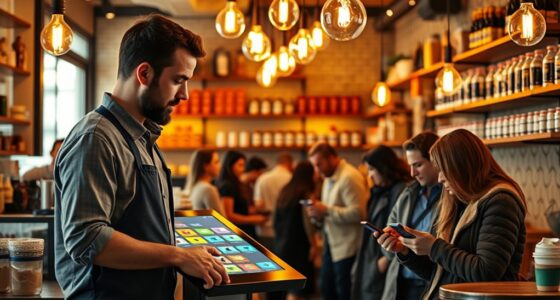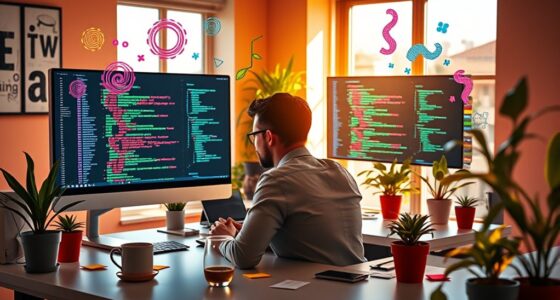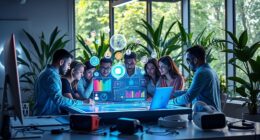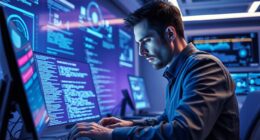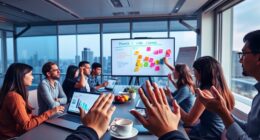Artists are using vibe coding to merge their creative visions with technology, allowing for quick prototyping and innovative project development. This approach lets you focus on artistic goals while AI manages the technical aspects. You can create interactive installations and generative art, explore multimedia integration, and experiment with rapid iterations. However, there are challenges and ethical considerations to navigate. Discover how vibe coding is reshaping artistic practices and what the future holds for this exciting intersection.
Key Takeaways
- Artists leverage vibe coding to transform creative ideas into digital formats, allowing them to focus on artistic vision rather than technical coding tasks.
- AI tools assist in generating initial concepts, enhancing creativity by managing repetitive tasks and enabling rapid concept refinement in various artistic fields.
- Vibe coding facilitates rapid prototyping, enabling artists to create and iterate designs quickly, fostering collaboration and communication among team members.
- Generative art utilizes algorithms to create unique visual experiences, allowing artists to embrace randomness and complexity while prioritizing creative expression over technical constraints.
- Ethical considerations surrounding ownership and originality in AI-generated art are crucial, prompting artists to navigate the implications of using AI in their creative processes.
The Concept of Vibe Coding in Art
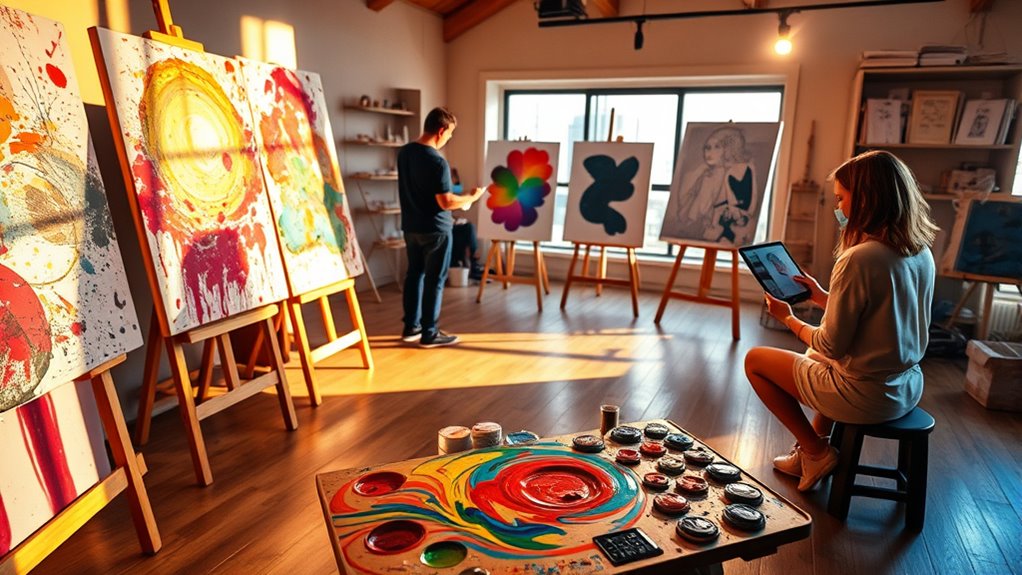
Vibe coding in art transforms how you bring your creative ideas to life by allowing you to describe your concepts in natural language. This innovative approach lets you focus on what your project should accomplish, while AI handles the technical coding.
By using AI tools, you can translate your artistic visions into digital forms without needing deep coding knowledge. Recent advancements in AI make vibe coding more accessible, enabling rapid prototyping and iterative refinement of your projects. As reports indicate that AI writes 95% of code in top startups, you can experiment with new styles and effects, enhancing your creative freedom. This method also fosters collaboration across disciplines, bridging the gap between technology and art, so you can release your creativity without getting bogged down by technical details. Additionally, vibe coding empowers artists to leverage advanced AI capabilities, enhancing their imaginative processes and expanding their creative horizons.
Enhancing Creativity Through AI Collaboration
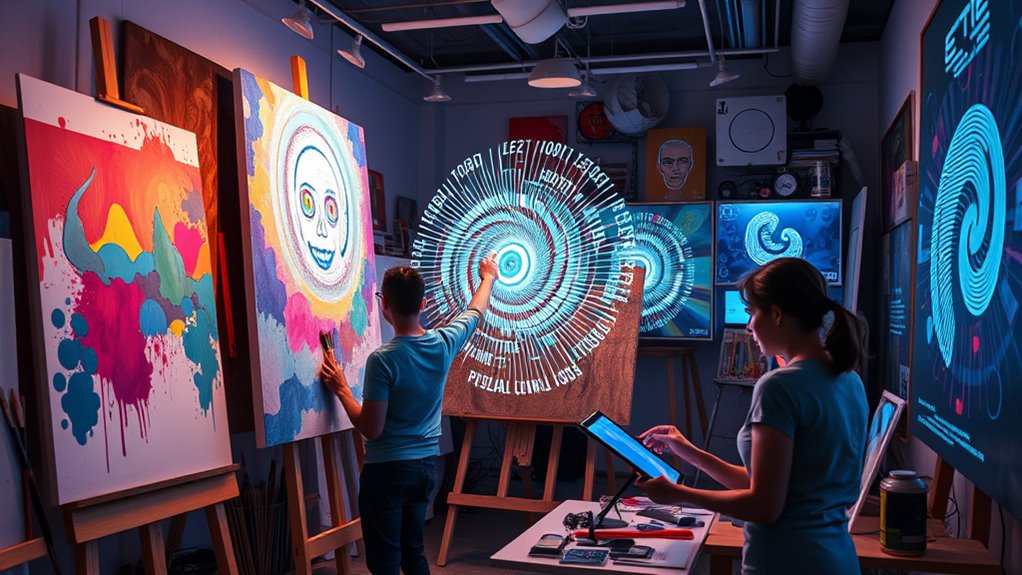
As creative minds increasingly embrace AI collaboration, new avenues for artistic expression are emerging. AI tools, like DALL-E 2 and Midjourney, help you generate initial concepts that you can refine, transforming how you approach visual arts. Moreover, successful AI implementations augment human creativity, allowing you to focus on refining your artistic vision while the technology handles repetitive tasks.
AI collaboration is revolutionizing artistic expression, enabling creative minds to generate and refine concepts like never before.
In music, AI algorithms inspire fresh melodies and soundscapes, pushing your creative boundaries. For designers, AI enables rapid generation of diverse concepts, streamlining the creative process. In advertising, AI creates initial visuals that you can enhance for emotional impact. Collaborating with technologists and AI researchers opens up innovative possibilities, blending traditional artistry with cutting-edge technology.
This fusion not only enriches your creative journey but also helps you overcome blocks, iterate faster, and produce more compelling works.
Rapid Prototyping for Artistic Innovations
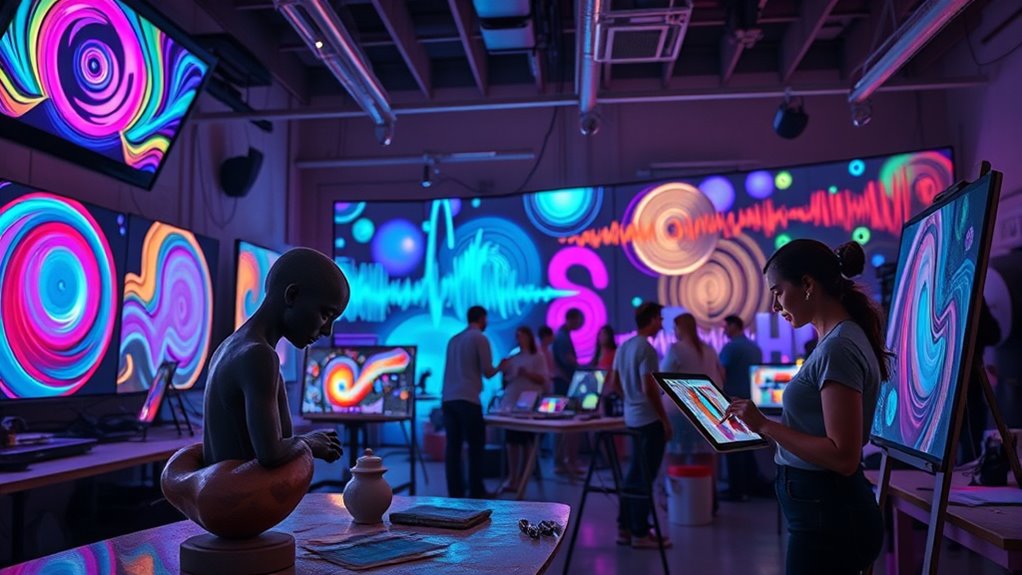
The integration of AI in creative processes naturally paves the way for rapid prototyping, a game-changer for artists.
With advancements in 3D printing and laser cutting, you can create intricate designs quickly and accurately. This flexibility allows you to explore multiple iterations without significant time or cost investment, fostering experimentation and risk-taking. Rapid prototyping accelerates innovation by enabling artists to iterate quickly and test their ideas in real-time. Furthermore, the use of data analytics in design feedback can significantly enhance the refinement process.
You’ll find that tangible prototypes enhance communication among team members, ensuring everyone shares the same vision.
Rapid prototyping not only accelerates your design cycle but also lets you gather immediate feedback from audiences, refining your work to better meet expectations.
Ultimately, these technologies empower you to bring innovative projects to market swiftly, capitalizing on trends and opportunities in the ever-evolving art landscape.
Creating Interactive Installations
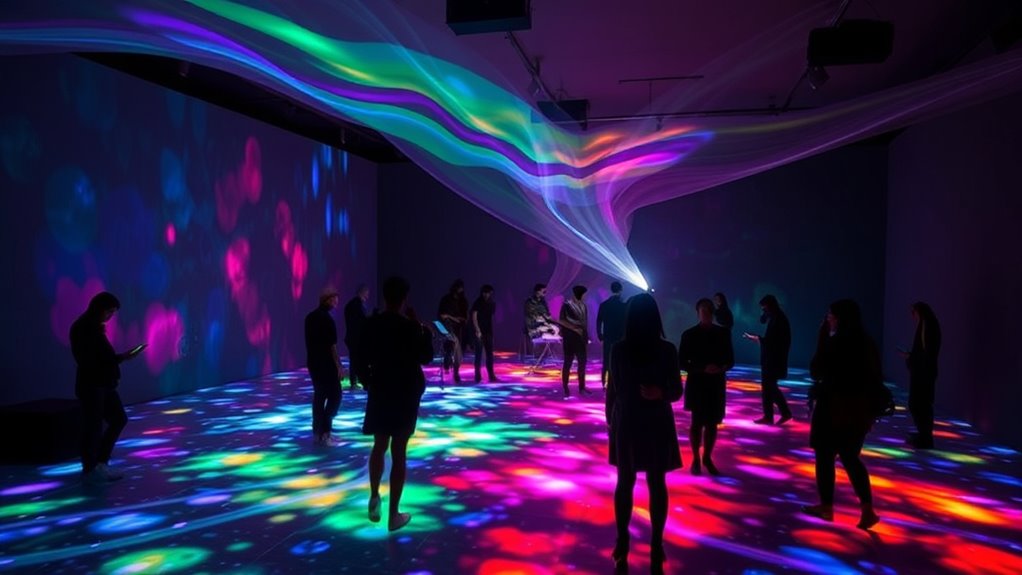
Creating interactive installations transforms the way audiences engage with art, as artists can now harness AI to enhance both the experience and the creative process.
By utilizing AI tools, you can generate dynamic elements that respond to user interactions, making your installation more engaging. With natural language inputs, you don’t need extensive coding knowledge, allowing you to focus on your creative vision. Additionally, testing and debugging are crucial throughout the development process, ensuring a smooth integration of technology into your artistic vision. Furthermore, the latest breakthroughs in machine learning tech enable artists to create more sophisticated interactive elements that enrich the audience’s experience. This approach exemplifies how creativity can be cultivated by anyone, regardless of technical background. AI-driven education programs increase knowledge among artists, empowering them to utilize these technologies effectively. Moreover, AI’s role in traditional drug discovery illustrates how these advancements can influence various fields beyond art, offering new perspectives on problem-solving.
Collaborative tools like Replit and voice dictation software streamline development, letting AI manage the technical details. This fusion of physical and digital elements creates immersive experiences that captivate visitors.
Furthermore, AI’s ability to analyze interactions helps adapt installations in real time, ensuring that each encounter is unique and memorable.
Embrace this technology to elevate your artistic expression!
Developing Generative Art
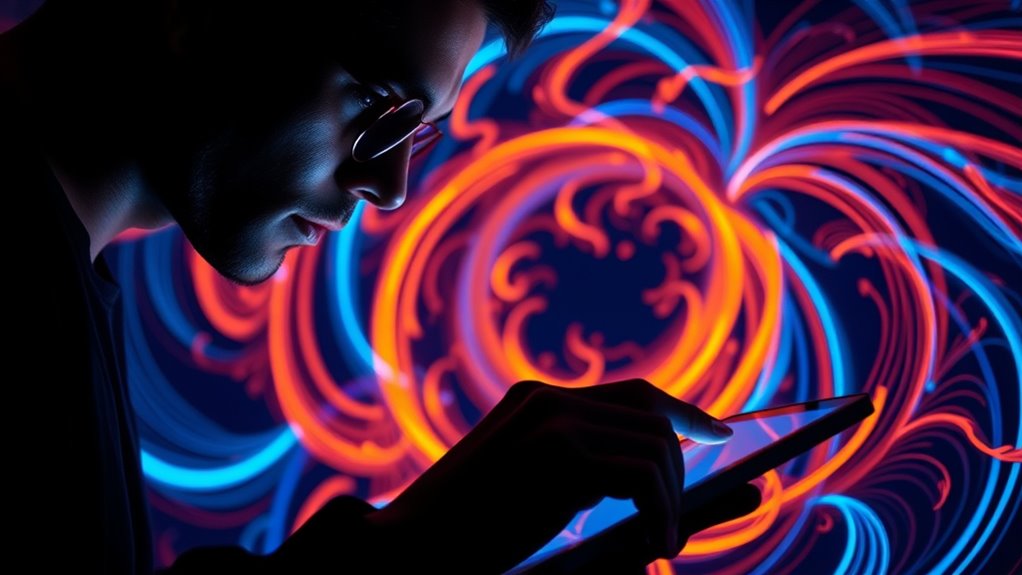
While exploring the world of generative art, you’ll find that algorithms serve as the backbone for creating striking and unique visual experiences. Embracing randomness allows your artwork to evolve unpredictably, resulting in diverse expressions. Techniques like recursion help you generate intricate patterns, while feedback loops enable ongoing innovation as outputs become new inputs. You can experiment with fractals, noise functions, and particle systems to introduce complexity and fluidity into your creations. Tools like Processing and Adobe After Effects simplify the process, making it accessible even if you lack extensive coding skills. By iterating and refining your work, you’ll enhance color, texture, and depth, ultimately pushing the boundaries of traditional artistic expression into a dynamic digital domain. This approach to art challenges traditional notions of authorship and emphasizes the collaborative nature of algorithmic creation.
Integrating Multimedia Projects
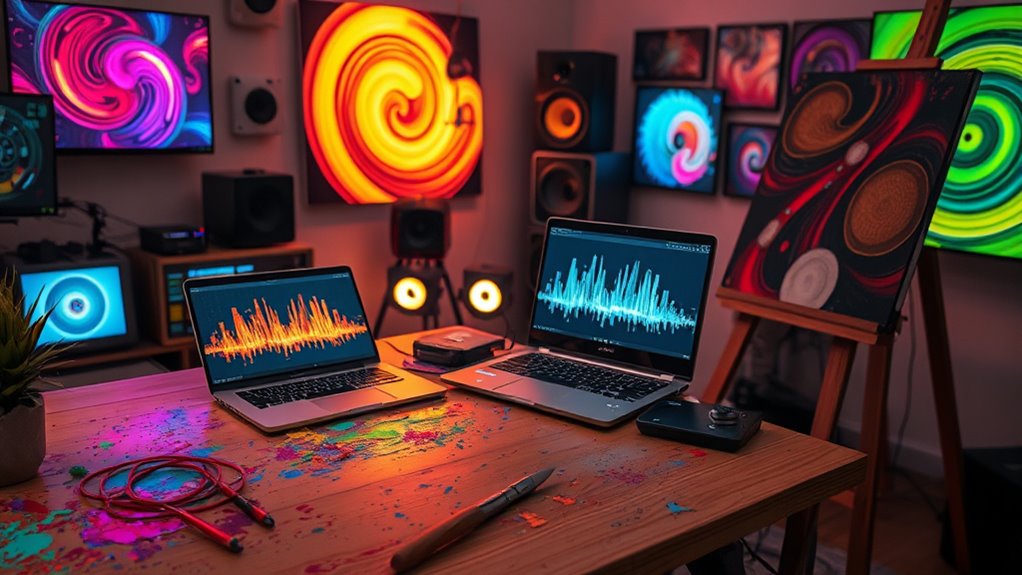
As you explore integrating multimedia projects, you’ll discover how various elements come together to form a cohesive experience.
AI-powered design tools let you generate graphics and layouts just by describing your vision, streamlining the process. You can communicate naturally with AI systems, making it easy to implement various multimedia elements. The emergence of vibe coding enables artists to bring their ideas to life without needing to master technical skills.
This shift reflects a growing emphasis on creative expression in the digital age, allowing artists to prioritize their unique visions. Automated coding accelerates development, allowing you to focus on creativity rather than technical details. Feedback loops enable continuous refinement based on user input, enhancing your project’s effectiveness.
Overcoming Challenges in Vibe Coding
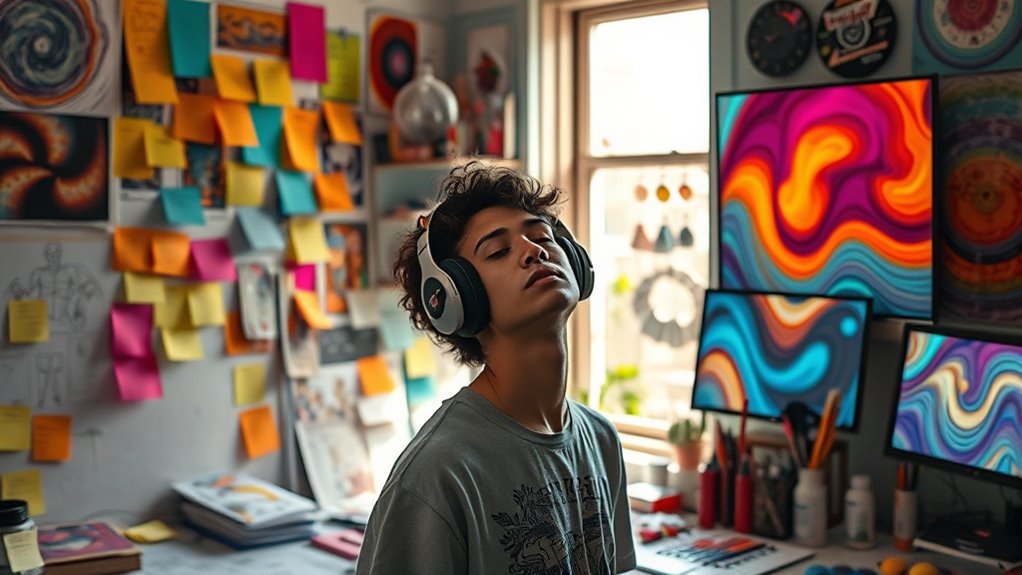
Overcoming challenges in vibe coding can feel intimidating, especially with the rapid pace of development that often leads to overlooked security and technical issues.
You might find limited control over external libraries restricts secure integrations, while the rush to prototype can cause you to overlook crucial security considerations. Relying heavily on AI tools can introduce vulnerabilities, complicating debugging without a solid technical foundation. Additionally, the speed of vibe coding can build up technical debt, making future maintenance tough. To manage complexity, consider using sandbox environments and developing a tiered skillset within your team. Embracing the vibe coding approach can lead to unique and innovative solutions, even amidst these challenges.
Future Trends in Artistic Applications
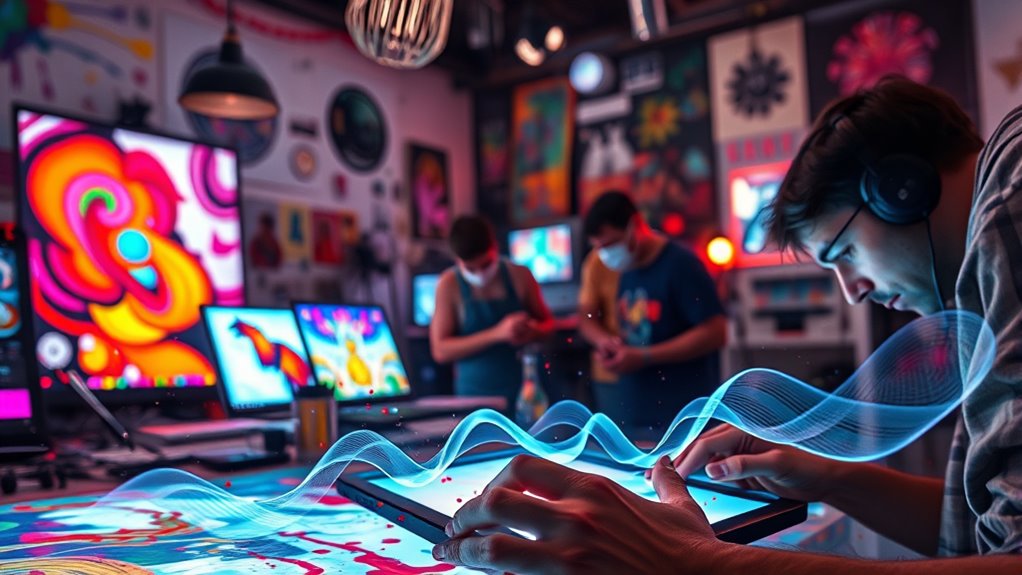
Given the rapid evolution of technology, vibe coding is transforming the landscape of artistic applications by offering unprecedented opportunities for personalization and innovation. You can create unique pieces of art tailored to individual descriptions, making your work more relatable and engaging. With AI’s help, you’ll reach broader audiences through interactive experiences that resonate emotionally. This tech not only boosts efficiency by automating code generation but also opens doors for collaboration with AI, enhancing your creative process. As vibe coding evolves, expect to see new art forms emerging, simplified creation processes, and an expansion of artistic capabilities. Vibe coding enables artists to create customized solutions without extensive programming knowledge, further enriching the creative landscape. Embracing these trends will position you at the forefront of the artistic revolution, allowing for limitless creative exploration.
Ethical Considerations in AI-Generated Art
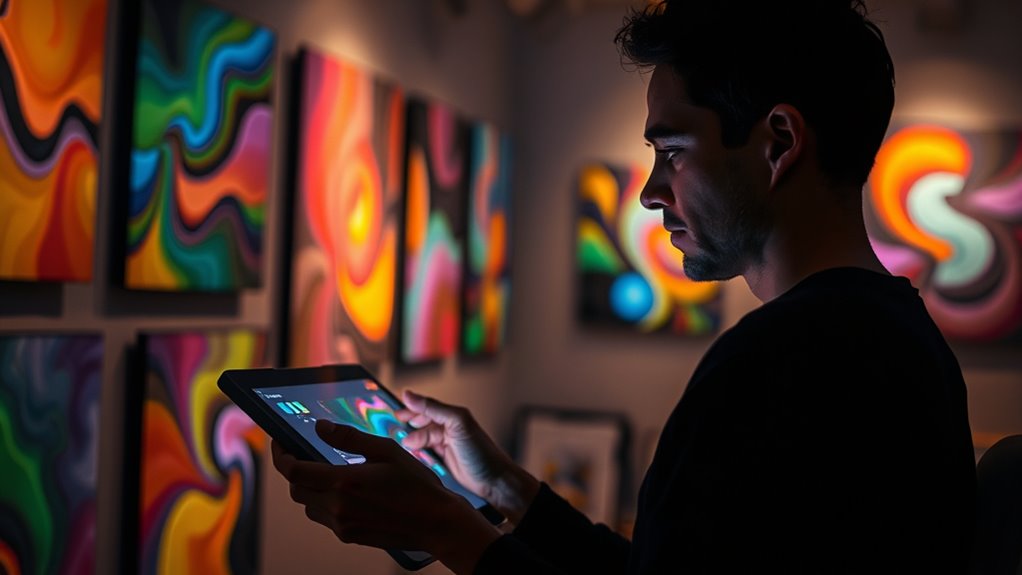
While technology has opened new avenues for creativity, it also raises significant ethical concerns in AI-generated art that artists and audiences must navigate. You might wonder about ownership and originality, especially when AI is trained on copyrighted works. Bias and stereotypes can seep into AI outputs without scrutinizing training data, potentially underrepresenting certain groups. Transparency is essential; artists should clearly communicate AI’s role in their work. Furthermore, many AI-generated pieces rely on uncredited artists, raising consent issues. As regulations struggle to keep pace with technological advancements, you’ll find a need for ethical frameworks that address these challenges. Engaging in these discussions is imperative for fostering trust and ensuring responsible use of AI in your creative projects. Moreover, the importance of scrutinizing training data cannot be overstated, as it plays a crucial role in shaping the outputs generated by AI systems. To effectively navigate these ethical dilemmas, artists must understand ethical guidelines that promote responsible practices in AI utilization. Additionally, the rise of breakthrough technologies like AI in various sectors emphasizes the urgency of establishing these frameworks. The integration of AI in creative fields also highlights the necessity for transparency in AI algorithms, helping to build trust among artists and audiences alike.
Frequently Asked Questions
What Programming Languages Are Commonly Used in Vibe Coding?
In vibe coding, you don’t need to worry about specific programming languages. AI can generate code in various languages based on your project requirements.
Commonly, you might see languages like Python, JavaScript, and C++ used because they’re popular in software development.
Since vibe coding is language-agnostic, you focus more on describing what you want instead of the technical details, leaving the language choice to the AI.
This flexibility makes coding more accessible for everyone.
How Can Beginners Start With Vibe Coding?
To start with vibe coding, you’ll want a quick setup using tools like Windsurf or Replet.
Begin by experimenting with basic prompts, guiding AI to generate code. Don’t worry about perfection; focus on iterative prototyping to refine your ideas rapidly.
You can use voice or text input, depending on what feels comfortable.
Finally, check out learning resources like YouTube tutorials to deepen your understanding and enhance your vibe coding skills.
Are There Specific Tools Recommended for Vibe Coding?
If you’re diving into vibe coding, there are several tools you’ll want to explore.
Start with Replit Agent for its full-stack capabilities and support for multiple languages. An Integrated Development Environment (IDE) can help you with code generation using AI.
Don’t forget about AI-assisted code generation tools—they make creating front-end and back-end code a breeze.
These resources will streamline your development process and enhance your creative projects greatly.
What Are Some Successful Vibe Coding Art Projects?
Imagine creating a vibrant, interactive mural that changes colors based on the audience’s emotions.
Successful vibe coding art projects, like this, showcase how designers use AI to rapidly generate dynamic visuals.
By blending human creativity with AI’s coding capabilities, you can produce unique pieces that engage viewers on multiple levels.
This approach not only enhances design flexibility but also fosters collaboration, allowing you to focus on the creative aspects rather than technical details.
How Does Vibe Coding Compare to Traditional Coding Methods?
Vibe coding speeds up development compared to traditional coding by using AI to generate code from natural language prompts. You’ll find that it allows for rapid prototyping and saves time on routine tasks.
However, vibe coding can struggle with complex projects, limiting your control and flexibility. In contrast, traditional coding offers more customization and direct oversight, making maintenance and debugging more manageable.
While vibe coding is accessible, it may not suit every project’s needs.
Conclusion
As you explore vibe coding in your creative projects, consider that a recent study found 70% of artists using AI tools reported increased inspiration in their work. This statistic highlights how integrating technology can enhance your artistic vision and push boundaries. By embracing vibe coding, you can create interactive installations and generative art that resonate with audiences in new ways. The future of art is vibrant, and your unique voice can thrive in this innovative landscape.




